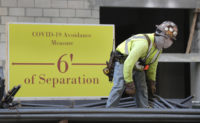Judging from the dismay that apparently helped convince the U.S. Occupational Safety and Health Administration to change its guidelines for employer-required COVID-19 vaccines—unlike the original guidelines, the latest revision won’t require employers to record adverse reactions in OSHA logs—the industry should keep a sharp eye out for what’s still to come from the agency.
A planned new comprehensive federal emergency temporary COVID-19 standard, currently being reviewed by the U.S. Office of Management and Budget, could entail even more vexing complications than the recently issued vaccine reaction guidelines. Such emergency temporary standards, executive orders or guidelines already exist in 14 states, but it’s not clear what the Biden administration U.S. Labor Dept., of which OSHA is a part, will learn from those states.
Having a separate COVID-19 log would prevent COVID cases from instantly altering the overall safety picture of a project or company, especially since we know COVID-19 spread and its causes may not reflect a lapse on the part of the employer.
Determining the difference between a recordable injury or illness and a reportable one, however, can involve subjective judgements.
Recordables, which require entries in a company’s log, are less severe and generally don’t involve hospitalizations or treatment with drugs or antibiotics.
Reportables, in contrast, require immediate notification to OSHA and have more severe consequences as far as medical treatment and inability to return immediately to work. The overall safety record is important in qualifying contractors for new projects and may help company managers gain higher compensation if they win those projects.
The record-keeping issues will be important when OSHA issues the temporary emergency federal COVID-19 standard. The Associated General Contractors and other groups ask that the agency “align its protocols” with those issued by the Centers for Disease Control and Prevention. The often-revised CDC guidelines have already generated a fair amount of confusion as understanding evolves of virus transmission and the effects of the vaccines.
Keeping them on the same page benefits everyone.
Another measure is even more critical. A coalition of employers, through a comment paper prepared by their attorney, has asked for a separate record for virus-related events and illnesses. In other words, OSHA would exempt COVID-19 from OSHA Standard 1904: Injury and Illness Recordkeeping and put virus entries in a different history or list.
The idea is based partly on reports of employer difficulties, and long hours spent, to determine whether the COVID-19 cases among employees are work-related and belong in the employer OSHA 300 Logs. This separate-record approach would not prevent inspection. The COVID-19 cases would be kept confidential but made available to employees or their representatives with personal identity information scrubbed. No party other than OSHA and local or regional health officials would have access to the separate record.
Under California's emergency temporary COVID-19 standard, employers must contact local health departments when there are three or more COVID-19 cases within a 14-day period in the same workplace, and give health officials information about the employees. This approach would allow the separate log to be useful in contact tracing.
But having a separate COVID-19 log would prevent virus cases from instantly altering the overall safety picture at a particular project or workplace. This is especially true because, as we know, COVID-19 spread and its causes may not reflect a lapse on the part of an employer.
Employers can follow all the various and changing rules to prevent transmission, yet still have the virus carried into the workplace.
With vaccination proving successful and COVID-19 science providing new insights, we look forward to the eventual sunset of the temporary emergency standard and a fresh understanding of how to deal with this public health crisis, even if it was achieved after 586,000 U.S. deaths.
This editorial was update May 26, 2021 to reflect the latest change in OSHA guidance.





Post a comment to this article
Report Abusive Comment